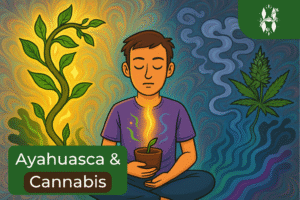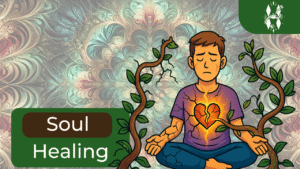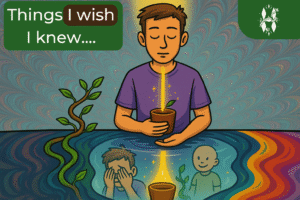Ayahuasca, a term now resonating across the globe, is known as a potent tool for personal transformation and healing. But to truly appreciate its impact, one must dive into its roots.
Where did Ayahuasca originate? What is it’s history? How did the indigenous of the amazon discover it? Let’s journey back in time to uncover the genesis of this sacred plant medicine.
Key takeaways:
- Ayahuasca’s origin is the amazon rainforest and is native not just to Peru, but also to Colombia, Brazil, Ecuador, Bolivia and Venezuela.
- How Ayahuasca was discovered remains a mystery. Many believe the indigenous observed the jaguar eating the chakruna leaves and trying it themselves. Others myths tell that shamans received messages in their dream to cook these two plants together.
- Different tribes of the amazon significantly separated by each other independently found Ayahuasca which adds further mystery to the origins of Ayahuasca.
Table of Contents
The Origins of Ayahuasca
Within the vast ecosystem of the Amazon rainforest lies the birthplace of Ayahuasca. While Peru has become synonymous and most famous for Ayahuasca, it’s essential to acknowledge that Ayahuasca’s roots extend across several countries including Brazil, Colombia, Ecuador, Venezuela, and Bolivia, basically where there is the Amazon rainforest.
What’s particularly intriguing is how multiple tribes within these regions, despite being significantly geographically and culturally separated, stumbled upon this unique combination of plants. Each tribe, with their distinct rituals and traditions, integrated Ayahuasca into their spiritual practices, which is truely remarkable and poses many questions as well.
Must read blog: What is Ayahuasca – the mystery of the amazon explained
How did the Indigenous Discover Ayahuasca?
The discovery of Ayahuasca by indigenous tribes is disguised with a lot of mysteries and legends. The idea of combining two specific plants from among the estimated 80,000 species found in the Amazon seems almost beyond belief. How did these ancient cultures pinpoint this particular symbiotic relationship between the Banisteriopsis caapi vine and the leaves of the Chacruna plant to produce such a profound psychoactive brew?
Many tribes have their myths and stories about Ayahuasca’s discovery.
Origin of Ayahuasca: Observing Nature: Learning from the Jaguar
Nature has always served as a profound teacher to indigenous cultures, offering insights and wisdom that have shaped their beliefs, practices, and daily lives. One striking example of this symbiotic relationship is the indigenous tribes’ observation of the Amazon’s apex predator: the Jaguar. The Jaguar, often regarded as the ‘king of the jungle’ (while the lion holds the title in the savannah), has been observed eating the Chacruna plant and having strange reactions after that.
To the tribes, this act wasn’t merely a random behavior but a significant cue. If such a majestic and powerful creature was drawn to this plant, surely, there was a deeper meaning and potential behind it. Chacruna is rich in DMT, a naturally occurring psychoactive compound. Upon ingestion, it can produce visions and altered states of consciousness, even before its combination with the Banisteriopsis caapi vine.
This observance perhaps gave the indigenous tribes the first tipp about the plant’s unique properties, prompting further exploration. The next challenge was to find its perfect partner to unlock its full potential, leading to the discovery of the synergistic relationship with the caapi vine. Through a combination of keen observation, respect for nature’s wisdom, and iterative experimentation, the indigenous tribes arrived at the brew we now know as Ayahuasca.
The Whisper of Plant Spirits: Shamans’ Dreams and the discovery of Ayahuasca’s recipe
The Shipibo tradition offers another perspective on the origins of Ayahuasca. Within this tradition, it is believed that the knowledge of Ayahuasca did not come merely from physical observation or experimentation but from a more ethereal and sacred source: the spirits of the plants themselves.
In tales passed down through generations, certain master shamans were chosen by the spirits to receive special visions in their dreams. Within these dreams, the spirits of the plants conveyed to the shamans the sacred knowledge of combining the Chacruna plant with the Banisteriopsis caapi vine. These revelations in their dreams were treated with the utmost respect and, upon waking, the shamans set forth to bring these dreamt combinations into reality, ultimately birthing the transformative brew of Ayahuasca.
While there are various theories and stories surrounding the discovery of Ayahuasca, these 2 explanations seam most comprehensive to many. Observing nature and the king of the jungle and discovery of this combination in a dream state when one can access other realism of consciousness.

The Lost Civilizations of the Amazon: The mystery of the past
The Amazon rainforest, often perceived as a sprawling expanse of untamed wilderness, holds many secrets and hidden tales that are still being uncovered today. Contrary to the traditional belief that the Amazon was sparsely populated with nomadic tribes, recent evidence suggests the existence of complex and advanced civilizations thriving amidst its dense foliage.
The video reference highlights a striking revelation: the Amazon, at one point in history, housed cities with populations exceeding 100,000 people. To put this into perspective, such numbers would rank these cities among the top ten largest globally during their era, as shown in the visual representation on Visual Capitalist. The very notion that such significant populations could thrive in what many would consider a challenging and hostile environment is truly astounding.
These lost cities of the Amazon are a testament to the adaptability, innovation, and resilience of its ancient inhabitants. The intricate relationship these communities had with the land and nature undoubtedly played a role in their understanding and ritual usage of Ayahuasca, a central element in the mysteries of the Amazon.
As we delve deeper into the stories and histories of this vast rainforest, we’re continuously reminded of its rich cultural heritage and the deep well of knowledge it holds, waiting to be rediscovered (and preserved).
Ayahuasca: Manifestation of a Spirit Within Nature
The profound relationship between the indigenous people and the vastness of the Amazon rainforest extends beyond the physical realm. To them, every element of nature is not just an entity but a manifestation of spirit and consciousness. This deep-seated belief forms the core of their understanding of Ayahuasca.
Ayahuasca isn’t merely a tea brewed from two specific plants; it’s seen as the embodiment of a spirit. When drinking Ayahuasca, this spirit comes to the participant of the drinker and helps them develop their consciousness in harmony with the consciousness of Ayahuasca. The experience is often described as transcendental, with the spirit of Ayahuasca serving as a guide, leading the individual on a journey through the depths of consciousness and the mysteries of the universe.
This understanding aligns with the reverence the indigenous hold for the Amazon. To them, the rainforest isn’t just a collection of trees, plants, and animals but a living, breathing entity teeming with spirits and energies. Ayahuasca is seen as one of the most profound expressions of this belief, encapsulating the wisdom of Mother Earth and the enigmatic allure of the Amazon. It’s a bridge between the seen and the unseen, the known and the mysterious, guiding those who partake on a journey of inner exploration and cosmic understanding.
The Gift of Ayahuasca in Modern Times
We stand at a unique crossroads in human history. The doors to ancient wisdom, often secluded within the heart of the Amazon, have been opened to the modern world, and Ayahuasca is one of these treasured keys. Our privilege to access such sacred traditions cannot be understated, and it comes with a responsibility.
Historically, the indigenous tribes have been protective of their rituals and traditions, and rightly so. Their apprehensions stem from past experiences where their cultures were misunderstood, appropriated, or even exploited. However, many see the urgency of the times we live in, recognizing the potential of Ayahuasca to bring about healing and transformation on a global scale.
This isn’t just about an individual’s quest for enlightenment or inner peace. The broader mission is to reconnect humanity with nature, with the essence of what it means to be human. Amidst the chaos, noise, and often dehumanizing pace of modern life, Ayahuasca serves as a medicine, guiding us back to our roots, instilling compassion, and fostering a deeper understanding of ourselves and the world around us.
There’s a profound hope that by sharing this medicine and its teachings, a ripple effect will occur. One that not only elevates individual consciousness but gradually permeates through communities and societies, creating a more harmonious, conscious, and connected world. The tribes of the Amazon have bestowed upon us a gift of immeasurable value, and it’s our collective duty to honor, respect, and utilize it with the deepest sense of responsibility.
If you want to connect with Ayahuasca, I invite you to consider our Ayahuasca Retreat Center in Colombia.
Conclusion
The journey of Ayahuasca, from the depths of the Amazon to the global stage, serves as a testament to the interconnectedness of our world and the shared human quest for understanding and healing. As we delve into the traditions, wisdom, and teachings that surround this sacred plant, it’s vital to approach it with respect, gratitude, and awareness of its origins. While Ayahuasca offers profound insights and transformation, it also reminds us of our responsibility to protect, honor, and cherish the indigenous cultures and ecosystems from which it emerges. Embracing this gift with integrity ensures that its spirit and essence remain undiluted for future generations.
What are the origins of Ayahuasca?
The amazon rainforest is the origin of Ayahuasca. It was discovered independently by various tribes all across the amazon and is now native to Peru, Colombia, Brazil, Ecuador, Bolivia and Venezuela
What indigenous tribes carry the tradition of Ayahuasca?
There are many indigenous tribes sharing Ayahuasca including the Camëntsá Biyá, Inga, Cofan, Shipibo-Conibo, Asháninka, Shuar, Quechua, Yaminahua (or Yaminawá), Matsés (or Mayoruna), Kaxinawá (or Huni Kuin), Ticuna, Tukano, Cashinahua (or Kaxinawá) and many more.
These tribes have their own unique traditions, songs, and rituals related to ayahuasca, but they all regard it as a medicine with deep respect for its transformative and healing properties.




